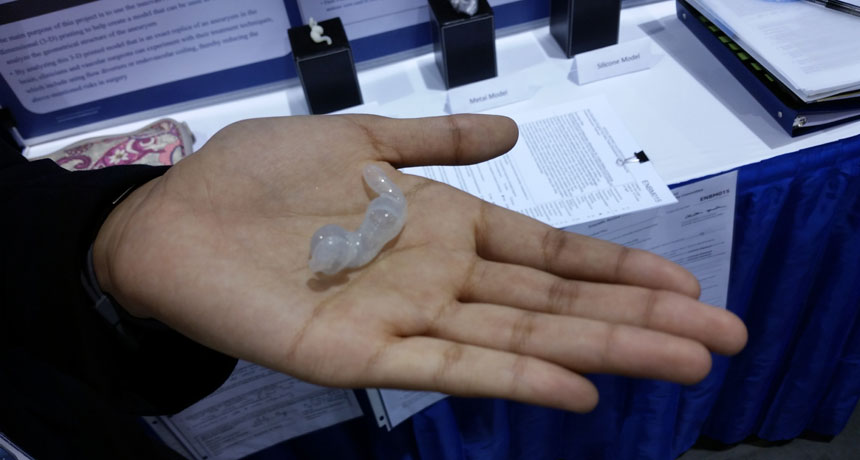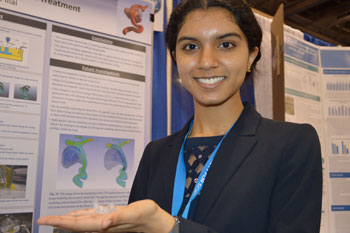Teen offers technology that could help brain surgeons
They can make full-scale plastic copies — to practice on — of some faulty tissue that needs fixing

A teen from Wisconsin has figured out how to make life-size models of blood vessel defects, called aneurysms. These could help doctors better prepare for tricky operations.
S. Perkins
By Sid Perkins
PHOENIX, Ariz. — There’s an old saying: Practice makes perfect. People usually think of this adage in relation to simple repetitive actions like throwing a football. Now, a teen has come up with a way to let brain surgeons practice intricate operations where the stakes are much higher.
There’s no doubt that surgery can, in general, be “practiced.” The more operations that doctors perform, the more skillful they tend to become. But every human body is slightly different. So doctors can easily run into unexpected problems when they open up the body. And no operation is riskier than brain surgery. That’s especially true when surgeons are trying to treat an aneurysm (AN-yur-izm).
These balloon-like bulges sometimes develop in the side of a blood vessel. They are typically weaker than other parts of the blood vessel wall. That puts them at risk of bursting, causing a hemorrhage. People with a small aneurysm may never have any symptoms — and live long lives. But large aneurysms pose many risks, including sudden death. They can occur anywhere in the body, but they’re especially dangerous in the brain. That’s because blood pressure there is particularly high. Plus, the delicate nerve tissue surrounding the bulge can be severely damaged by the high-pressure spray if a blowout ever develops. So, it’s often important to remove or patch brain aneurysms as soon as they’re discovered.
Some aneurysms stem from injuries. A larger share occur in tissue that developed abnormally, perhaps even in the womb. Because every aneurysm is different, treatment also can vary widely from one patient to another, explains Arundhati Pillai. This 17-year-old attends the University School of Milwaukee in Wisconsin.
Small aneurysms can be sliced away and sewn up. Others may be cauterized, or sealed off, by burning the affected tissue with a hot wire.

But 3-D printing typically creates an object that’s hard and solid. Blood vessels are hollow and flexible. So, Arundhati’s process adds a few extra steps. She described her approach here, on May 12, at the Intel International Science and Engineering Fair. Created by Society for Science & the Public and sponsored by Intel, this year’s competition brought together more than 1,750 students from 75 countries. (SSP also publishes Science News for Students.)
Arundhati uses a patient’s MRI to make a digital model of the aneurysm. Then, she 3-D prints a solid plastic copy of it. She hangs this hard plastic copy inside a small box and pours a gel-like material around it. This congeals to create a flexible mold. After slicing into the mold, she pulls the hard copy out.
Now, she pours some liquid metal into the mold. (That makes another solid copy of the aneurysm, Arundhati notes. But that metal has a low melting point, which becomes important in the final steps.) When the metal hardens, she pulls it out of the mold and dips it in liquid silicone.
After that coating firms up into a synthetic rubber, she heats everything again to melt the metal. It now flows out of the pliable silicone shell. Voila! What’s left is a life-sized model of the aneurysm that’s both hollow and flexible.
With such a model, doctors can get a much better idea of what an aneurysm looks like, says Arundhati. Long before an operation begins, they now can figure out the best treatment option. They might even make several copies so that they can try out different surgical techniques on it. Then, they can practice the best one until they’re comfortable the surgery will proceed smoothly.
All of this practice should allow the actual surgery to go more quickly — and, hopefully, successfully. Less time under general anesthesia should also reduce the overall risk to a patient, she adds.
Arundhati’s approach might also help doctors beyond the operating room. For instance, she suggests, it could help medical students who are training to be surgeons. The silicone aneurysms would allow these surgeons-to-be to practice operating as much as they like. After all, practice makes perfect.
Power Words
(for more about Power Words, click here)
anesthesia A medicine used to control pain. With what’s known as general anesthesia, the medicine seems to put someone asleep. The drug helps to control an individual’s breathing, blood pressure, blood flow and heart rate (and rhythm). It will relax patients, leaving them sleepy. Eventually, they will usually become unconscious. Some “local” anesthetics, however, just numb tissues around where the drug had been applied. In these cases, the patient will remain awake.
aneurysm A balloon-like bulge in the side of a blood vessel. These weak spots can occur in any vessel of the body but are particularly dangerous in major blood vessels or those perfusing the brain, where blood pressure is high.
brain scan The use of an imaging technology, typically using X rays or a magnetic resonance imaging (or MRI) machine, to view structures inside the brain. With MRI technology — especially the type known as functional MRI (or fMRI) — the activity of different brain regions can be viewed during an event, such as viewing pictures, computing sums or listening to music.
cauterize To burn tissue with a hot surface, coil of wire or a laser beam. On the outside of the body, doctors can remove moles or skin cancers by cauterizing them. Inside the body, doctors treat some conditions (such as aneurysms) by threading a wire through a blood vessel to their target and then heating its tip to sear the tissue.
digital (in computer science and engineering) An adjective indicating that something has been developed numerically on a computer or on some other electronic device, based on a binary system (where all numbers are displayed using a series of only zeros and ones).
hemorrhage A major or uncontrolled bleeding, often occurring internally.
magnetic resonance imaging (MRI) An imaging technique to visualize soft, internal organs, like the brain, muscles, heart and cancerous tumors. MRI uses strong magnetic fields to record the activity of individual atoms.
silicone Heat-resistant substances that can be used in many different ways, including the rubber-like materials that provide a waterproof seal around windows and in aquariums. Some silicones serve as grease-like lubricants in cars and trucks. Most silicones, a type of molecule known as a polymer, are built around long chains of silicon and oxygen atoms.
Society for Science and the Public (or SSP) A nonprofit organization created in 1921 and based in Washington, D.C. Since its founding, SSP has been not only promoting public engagement in scientific research but also the public understanding of science. It created and continues to run three renowned science competitions: The Intel Science Talent Search (begun in 1942), the Intel International Science and Engineering Fair (initially launched in 1950) and Broadcom MASTERS (created in 2010). SSP also publishes award-winning journalism: in Science News (launched in 1922) and Science News for Students (created in 2003). Those magazines also host a series of blogs (including Eureka! Lab).
symptom A physical or mental indicator generally regarded to be characteristic of a disease. Sometimes a single symptom — especially a general one, such as fever or pain — can be a sign of any of many different types of injury or disease.
three-dimensional (3-D) printer A machine that takes instructions from a computer program on where to lay down successive layers of some raw material to create a three-dimensional object.
three-dimensional (3-D) printing The creation of a three-dimensional object with a machine that follows instructions from a computer program. The computer tells the printer where to lay down successive layers of some raw material, which can be plastic, metals, food or even living cells. 3-D printing is also called additive manufacturing.







